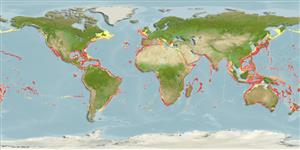Environment: milieu / climate zone / depth range / distribution range
Ekologi
laut bentopelagis; oceanodromus (Ref. 51243); kisaran kedalaman 100 - 975 m (Ref. 9302), usually 200 - 400 m (Ref. 6181). Subtropical; 55°N - 43°S, 180°W - 180°E (Ref. 6181)
Circumtropical and temperate seas of the world.
Size / Weight / umur
Maturity: Lm ? range ? - ? cm
Max length : 300 cm TL jantan/; (Ref. 5951); common length : 150 cm SL jantan/; (Ref. 6181); Berat maksimum terpublikasi: 63.5 kg (Ref. 4699)
Duri punggung (Keseluruhan (total)) : 13 - 15; duri punggung lunak (Keseluruhan (total)) : 15 - 18; Duri dubur: 0; Sirip dubur lunak: 15 - 18; vertebrata, bertulang belakang: 32. Skin very rough, scales interspersed with spinous bony tubercles. Mid-ventral (abdominal) keel on the ventral contour. Body is uniformly brown to dark brown, tips of the pectoral and pelvic fins black, margins of the second dorsal and anal fins white in young specimens.
Usually over the continental shelf, sometimes in oceanic waters down to 800 m (Ref. 9302). Usually solitary or in pairs near the bottom (Ref. 6181). Migrates far offshore (Ref. 26139). Pelagic (Ref. 5951). Feeds on fish, crustaceans and squid (Ref. 6181). The peculiar wooden 'palu' or Ruvettus hook is used to catch this species in south central Pacific (Ref. 6181). The flesh is very oily, with purgative properties, if eaten much (Ref. 6181). Marketed fresh and as fish cakes in Japan (Ref. 9302); also processed into fishmeal (Ref. 5217). Maximum length reported to reach up to 2 m only (Heemstra, pers. comm. 03/03).
Life cycle and mating behavior
Maturities | Reproduksi, perkembang biakan | Spawnings | Egg(s) | Fecundities | Larva
Nakamura, I. and N.V. Parin, 1993. FAO Species Catalogue. Vol. 15. Snake mackerels and cutlassfishes of the world (families Gempylidae and Trichiuridae). An annotated and illustrated catalogue of the snake mackerels, snoeks, escolars, gemfishes, sackfishes, domine, oilfish, cutlassfishes,. scabbardfishes, hairtails, and frostfishes known to date. FAO Fish. Synop. 125(15):136 p. (Ref. 6181)
Status IUCN Red List (Ref. 130435)
ancaman kepada manusia
Poisonous to eat (Ref. 4690)
penggunaan manusia
Perikanan: nilai komersial kecil; Ikan buruan: ya
Alat, peralatan
laporan khas
muat turun XML
Sumber internet
Estimates based on models
Preferred temperature (Ref.
123201): 8.6 - 19, mean 12.9 °C (based on 603 cells).
Phylogenetic diversity index (Ref.
82804): PD
50 = 1.0000 [Uniqueness, from 0.5 = low to 2.0 = high].
Bayesian length-weight: a=0.00347 (0.00191 - 0.00629), b=3.10 (2.93 - 3.27), in cm total length, based on LWR estimates for this species & (Sub)family-body (Ref.
93245).
Trophic level (Ref.
69278): 4.2 ±0.57 se; based on food items.
Daya lenting (Ref.
120179): Rendah, Waktu penggandaan populasi minimum 4.5 - 14 tahun (Assuming tm>4).
Prior r = 0.28, 95% CL = 0.19 - 0.42, Based on 1 data-limited stock assessment.
Fishing Vulnerability (Ref.
59153): Very high vulnerability (90 of 100).
Climate Vulnerability (Ref.
125649): Moderate vulnerability (38 of 100).
Nutrients (Ref.
124155): Calcium = 17.3 [7.8, 32.2] mg/100g; Iron = 0.573 [0.271, 1.108] mg/100g; Protein = 17.7 [15.5, 19.7] %; Omega3 = 0.202 [0.110, 0.353] g/100g; Selenium = 81.8 [36.6, 171.9] μg/100g; VitaminA = 10.3 [3.2, 36.7] μg/100g; Zinc = 0.411 [0.288, 0.611] mg/100g (wet weight);
